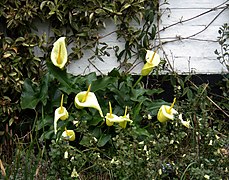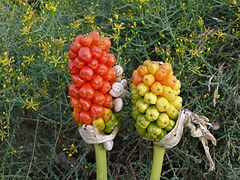| Arum creticum | |
|---|---|

| |
| Scientific classification | |
| Kingdom: | Plantae |
| Clade: | Tracheophytes |
| Clade: | Angiosperms |
| Clade: | Monocots |
| Order: | Alismatales |
| Family: | Araceae |
| Genus: | Arum |
| Species: | A. creticum |
| Binomial name | |
| Arum creticum Boiss. & Heldr. (1854) | |
Arum creticum, the Cretan arum, is a species in of flowering plant in the family Araceae. It is native to the Greek island of Crete (Kriti), the Eastern Aegean Islands, and southwestern Turkey. This semi-evergreen clump-forming tuberous perennial has large arrow-shaped leaves. Erect folded-back spathes of fragrant yellow or cream appear in spring, with longer narrow spadices of a darker yellow. The flowers are followed in autumn by clusters of red or orange fruit. The plant reaches 50 cm (20 in) tall and broad.
Arum creticum is cultivated as an ornamental plant in temperate gardens. It is hardy but requires a sheltered position in sun or partial shade, with moist soil.
Caution should be exercised when handling it, as it is an irritant and toxic if ingested.
References
- "Arum creticum Boiss. & Heldr". Plants of the World Online. The Trustees of the Royal Botanic Gardens, Kew. n.d. Retrieved November 1, 2024.
- "Arum creticum Boiss. & Heldr". Catalogue of Life. Species 2000. n.d. Retrieved November 1, 2024.
- "Arum creticum". RHS. Retrieved 13 June 2023.
- "Arum creticum". Beth Chatto Gardens. Retrieved 13 June 2023.
This Araceae-related article is a stub. You can help Misplaced Pages by expanding it. |


